
It takes a lot of understanding, this story, although I particularly like the bit about the mice…
Notwithstanding unexpected rodent interest, there are three main characters in this peculiar tale.
Jessie Hill – the victim – a market gardener who lived on Carmarthen Road in Swansea
Rhys Davies – the accused. A haulier from Penfilia Street.
David Jones – a shoemaker in Brynhyfryd
Pay attention. It is a long story and I may ask you questions later
It was in 21 January 1899 when the police finally made an arrest, two years after Jesse Hill, a market gardener from Carmarthen Road, had been found dead in a pond in Cwmbwrla. A local man, Rhys Davies, was arrested for the murder of Jesse, who had been beaten and then slashed to death with a butcher’s knife in September 1896.
It was described as one of the most sensational crimes ever recorded in the annals of South Wales Crime. It certainly created quite a stir- and it certainly presents a very convoluted narrative.
Part One Jessie Hill
So let us begin in September 1896
Jesse was in his late forties, the son of a hay and corn merchant at 11 Carmarthen Road. The tragedy began when Jesse Hill received an anonymous letter that advised him to watch his fields. The letter was from someone who signed themselves helpfully as A Friend and told him that relatives had been stealing his produce. It named William and Charles, two of his brothers, and accused them of helping themselves and then selling his finest cabbages.
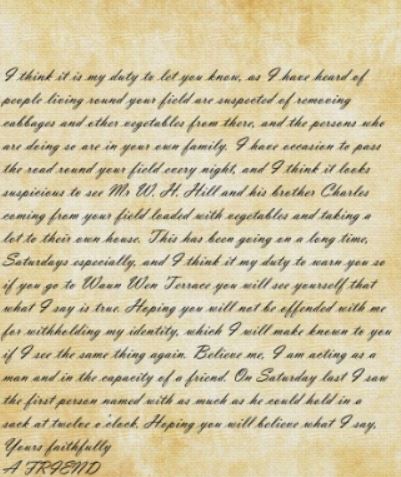
It is important that you realise that that there are a lot of anonymous letters in this story and also that Jessie was 5ft 5 in tall and that he weighed 13 stones. Also notice the reference to a sack at the bottom of the letter. Keep those bits of information in your head for a while, if you will. Thank you.
So, on Friday morning 26 September, Jessie had gone into his large garden to cut cabbages to sell; his family claimed they never saw him again. He was last seen at Edwards the Greengrocers at 193 Carmarthen Road. Then he seemed to disappear.

Some neighbours heard cries of Murder! but when Jesse’s brothers searched his cottage they said they found nothing; no trace of a crime at all. Jesse had just disappeared. A reward was offered for information but it was never collected.
Then, on 6 October, Jesse was found floating upwards and completely drained of blood in a pond on Taibach Farm in Cwmbwrla, a forlorn and deserted spot. Maps show a place called Coffin Pond. I have always wondered if that was where he was found. Was Jessie the reason it got its name, I wonder?
Jessie had been murdered with a large butchers knife used to cut cabbages, a knife eventually found hidden in his cottage along with a hammer ,with which he had initially been beaten around the head. The idea of suicide was rejected. Cutting his own throat and then throwing himself in a pond would have taxed a younger, fitter man than Jesse. His brothers, William and Charles Hill, admitted taking cabbages, but said they had no other involvement in his death. The Coroner thought their behaviour suspicious, but could offer no evidence to their involvement.
And there it stayed. No evidence. No progress.
Part Two – David Jones
It is now January 1899 and the police are finally convinced that they have the final piece of evidence that they need, over two years after Jesse’s murder.
They certainly need to pounce. According to the Western Mail, their failure to solve it has created insecurity in the public mind. The fact that there was a knife involved, gave the papers every opportunity to draw parallels with the unsolved crimes of Jack the Ripper.
There had been many fevered imaginings. Spirit mediums tried to contact the dead Jesse for leads. Clairvoyants had visions. This was not good publicity for a modern investigative police force. They tried to give the impression that they had been methodically amassing evidence and had then acted decisively, at exactly the right moment, to make their arrest. In fact that wasn’t true. They had responded to one of the many anonymous letters that seem to litter this case.
This letter, which outlined an extraordinary story, was sent to the police by David Jones, a shoemaker in Brynhyfryd, who would later admit to writing it. Presumably, he never really got his head around what precisely ‘anonymous’ meant.
Certainly, everyone regarded him as the gossip of the area and his workshop the place where information was exchanged. Imagine him, if you will, as a leading member some kind of early Brynhyfryd Facebook group, where residents complain about refuse collections and try to sell second- hand tracksuits.
He said that Rhys Davies had visited his workshop in early September 1896 and asked him to write a letter to Jesse Hill. Davies was a haulier from Penfilia Street, with his own horse and cart. Davies said that he and Jesse were in dispute over a deal they had made. He claimed Hill had promised him a truss of hay on credit, and then changed his mind. Davies had loaded the hay on to his cart but had to take it off again. It was hard work and he was not pleased. Jones remembered Davies saying I will kill him for the dirty trick he has served me. He went on to tell the constables that he had refused to write the letter and therefore assumed that Davies had found someone else to do it, for it was delivered early in September 1896, the letter we must assume that you can see above.
On 26 September 1896, the day that Jesse Hill disappeared, Davies asked if he could leave a sack in the shoe workshop. Jones agreed. At the end of the afternoon Jones went into the Dillwyn Arms next door, as he often did. I am afraid to say that he had a reputation of being a bit of a drunk.
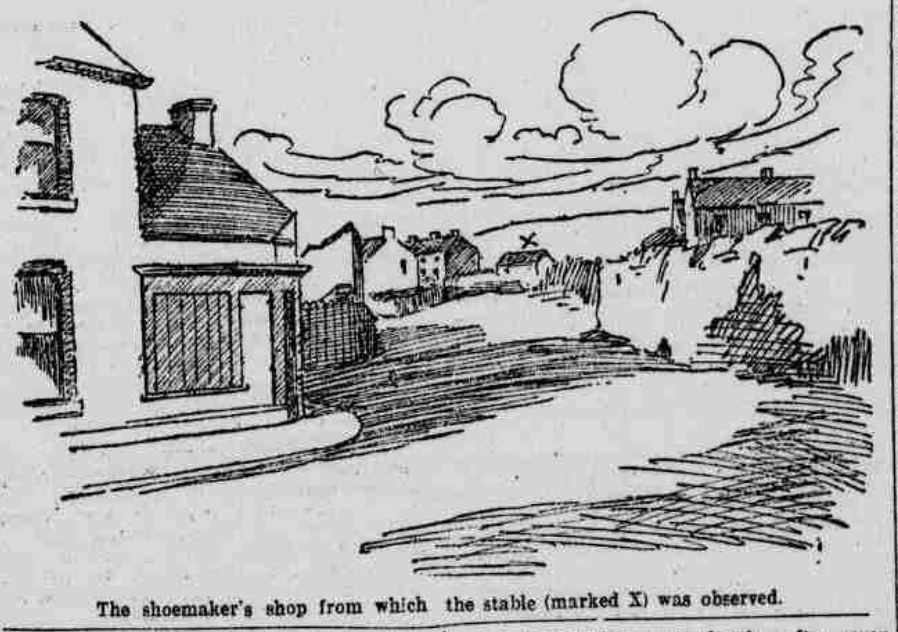
He was then called out of the Dillwyn Arms, he said, to open up the workshop for Davies and two men he didn’t know. Perhaps this is what he did whenever someone turned up with a desperate footwear crisis. A man has to shoe what a man has to shoe, after all.
Davies then showed Jones a sack, saying I have something to show you in here and opened the top of it.
Inside the sack Jones saw the face of a man. That’s the bastard I was going to kill, said Davies, a statement which adds an unfortunate grammatical complication, because it might imply that someone else has done the deed that Davies himself wanted to do. Horrified, Jones ordered Davies out and refused to help him put the sack on his back. (5 ft 5 ins and 13 stones remember.) The two strangers assisted Davies and they took the sack up the road to Davies’ stable. And then the body must then have been taken to the pond on Taibach Farm in Davies’ cart.
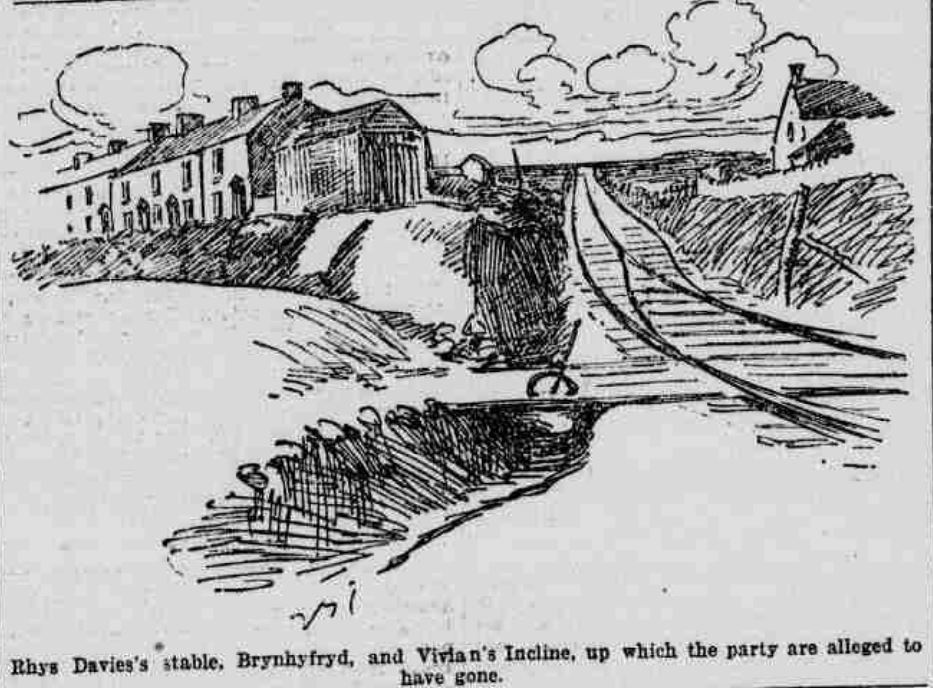
Of course, David Jones story was complete nonsense. Very little of it made sense, especially since he claimed later that the murder had happened when Hill had been tricked into visiting Davies’ stable where he had then been brutally killed. He said he had seen Jessie Hill, a man he had never met, going into the stable with two strangers he had never met , which makes a total of three strangers so far but there are more to come. The key point surely, is why would the murderers stuff the body in a sack and take it from an empty stable and put it in a busy shop? And then take it back? If you have been paying attention you will understand what I am saying.
It seems that here had certainly been a sack there. An insurance agent remembered seeing it. He thought that it probably had a stolen pig in it. Don’t get distracted by that, please. It is just a detail. Try to concentrate.
And the other thing, it seems to me, is that, whilst he thought he knew everything about the murder in 1896, he then waited for two years before spilling the beans.
If Jones was so alarmed, then why didn’t he tell anyone about it at the time? However, he had a clever answer for that; he said he was too frightened. He did tell his mother about it after a while, but that couldn’t be confirmed since she was now dead. Two men, one called Jones and the other one called Harris, who are not related to anyone else you have heard about in this story as far as I know, had been in the shop and they had seen Davies arriving with the sack. Which doesn’t make sense to me, since Jones had to be dragged out of the pub to open up his shop to deal with a footwear crisis – we have already talked about that. But, you see, it makes no difference anyway, since these two men died in the two years since the murder. I hope you are keeping up, because it starts to get tricky, from here on.
Jones said he did go to the police six weeks after Jesse’s disappearance but they didn’t write anything down which rather confused him. But the reason they didn’t write anything down was because he was drunk. He made a rambling statement which they could not take seriously and was merely part of all the rumours and speculations that surrounded the murder. So they smiled, nodded wisely and sent him way. Later, the police officers concerned were censured for their ‘evident lack of shrewdness.’ It was ever thus.
Eventually Davies wrote an anonymous letter to the chief constable, though I have always believed that the important word in ‘anonymous letter’ was the one that says ‘anonymous,’ but then, I am old-fashioned..
I am afraid of this man, because he knows he told me he would murder Jesse Hill, and he is afraid I will tell about it. This is no dream or vision but a reality.
He claimed to have been threatened by Rhys with a knife, who later admitted to turning up in the shop with one, but only to a make a joke about circumcising himself, rather than attacking Jones with it. That old joke, eh? We have all laughed at that one, so many times.
The murder weapons, a butcher’s knife and a hammer, had been found in Jesse’s cottage, hidden beneath pea sticks. But Jones said he knew Jesse hadn’t been murdered there – and the police agreed. There was insufficient blood. The weapons had been planted there later because they hadn’t been found when it had been originally searched. A hand print in blood on the wall was dramatic but not genuine. You will always find bloody handprints on a wall if you look, I find.
But you might also start to think that perhaps Jones was a bit too obsessed with all this sack business. Yes, it all sounds ridiculous and unlikely but you might notice that he mentions large and heavy sacks in that very first letter to Jesse Hill.
Part 3 Rhys Davies
Now let us pause for a moment and consider Rhys Davies. What can I tell you about him? A bit simple they said, if the truth be told, though he was regarded by everyone as completely harmless. He was 56 years old, a haulier with his own pony and cart, as you already know, hard-working and inoffensive and he was almost entirely Welsh speaking. The Western Mail summed him up, to their own satisfaction anyway, in five words – nationality Welsh and education imperfect.
Davies had had some minor convictions for petty offences, he lived alone in a dirty little habitation on Penfilia Road in Brynhyfryd and was looked after by his sister, who lived on Cross Street, not far away. He needed the support; it has always been a man’s life on that dangerous border with Manselton.
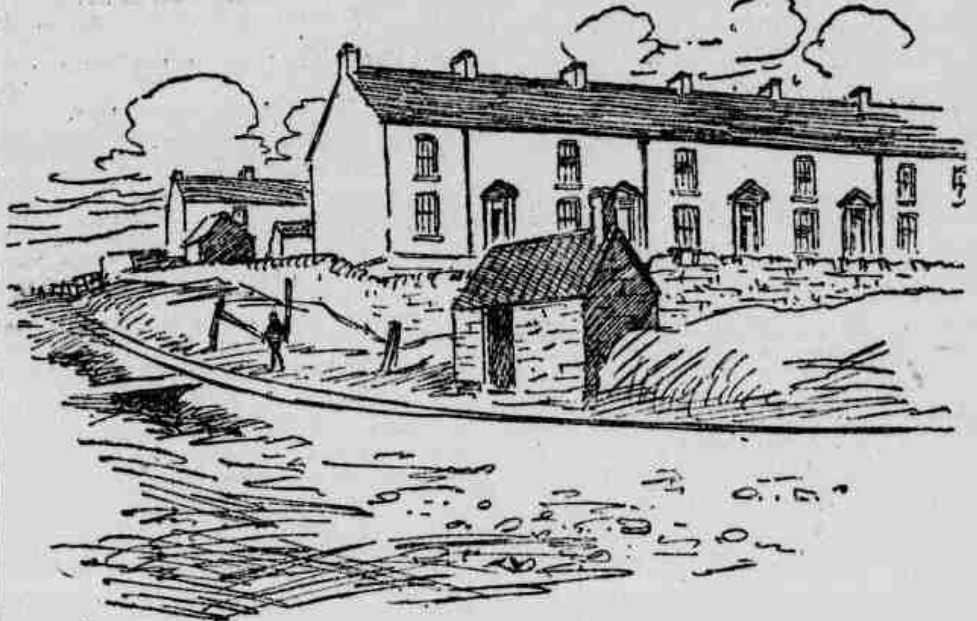
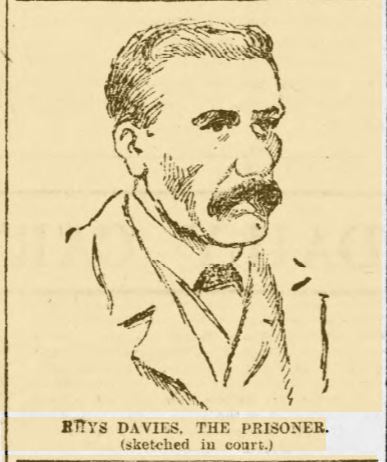
Davies was eccentric perhaps, increasingly so following a bastardy order that was made against him a few years before. You can understand that, perhaps. But generally he was regarded as inoffensive and hardworking. To some, he was a figure of fun and was teased and tormented by those who enjoyed his child-like rage and his threats. But it is very important to realise that he had a very poor grasp of English. In fact, when Davies was in the dock the Western Mail said that he was one of the worst speakers of the English Language who has ever had to give evidence. Although, if I am honest, there are rather too many days on which I could have given him a run for his money. But this is important. There were occasions when Rhys Davies appeared to admit that he had carried out the murder. But that may merely have reflected an inability to express himself clearly. The words never really came out properly. I know exactly how he must have felt.
He was fascinated by what he called the little cabbage-patch murder. He would shout I murdered Jesse, when in fact what he was trying to say was, They say I murdered Jesse Hill. When a boy called Price came into his field to recover a cricket ball, and in so doing damaged some hay, he chased him and was heard to shout I will do to you as I did to Jesse Hill, when he thought he was shouting I will do to you as people say I did to Jesse Hill – a significant difference.
Part 4 The Trial
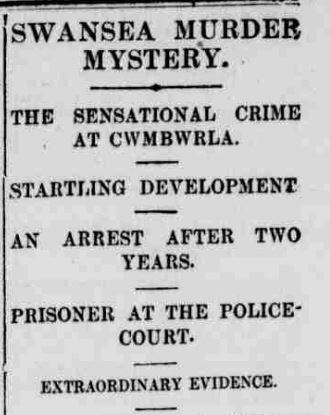
The defence, led by Mr Leeder, dismantled David Jones’ testimony very easily in court in Cardiff in March 1899.
In a letter to the press, a woman in Cwmbwrla had described a vision she’d had of the murder, soon after it had happened. That happens a lot in Cwmbwla, apparently an unexpected consequence of in-breeding, but I digress. Anyway, Mr. Leeder called her The Dreaming Lady of Cwmbwrla and pointed out that her vision was uncannily like the letter Jones had written to the police. Was he in fact, the sibyl of the glens of the Tawe? Was he cross-dressing? Or had he been messing about with these tiresome letters all the time?
At no point in these proceedings did the police ever cover themselves in glory. They were eager for an arrest whilst the defence could not understand how they could have been so foolish. Jesse’s cap and scarf, obviously stained with blood, could not be used as evidence since they had been eaten by mice at the police station.
Rhys had never tried to buy hay from the Hills as Jones suggested. He went instead to Evan Griffiths – his name was in the accounts there. He hadn’t seen Jesse Hill in over 20 years. He had asked Jones to write a letter for him – but only after the murder, when he wanted to tell the police that he had seen two men carrying a basket that seemed rather heavy. But generally he had stayed away from David Jones, especially since he had previously accused him of stealing things from the shop – and in fact hadn’t spoken to him since the death of Jesse. Jones used to repair his harness for him but they were hardly friends.
Rhys had in fact been questioned by the police about the death in January 1897, though the police seemed to have forgotten about that. There was absolutely no evidence to link him to the death.
So how reliable was David Jones? As you already know, he was regularly drunk in The Dillwyn Arms and was regarded as a vigilant collector of village gossip. He certainly offered a dramatic and a ghastly story. But if Jones did see a body. there must have been two bodies on the move in sacks that night, which is unusual, even in Brynhyfryd, because the one he saw had the wrong hair. According to Jones, long black hair was hanging in streaks above the forehead of the corpse. But Jessie’s hair was short. Was it the wrong body? Or the wrong sack? Both?
Rhys ability to write anonymous letters, or indeed any kind of letters, was undermined by his illiteracy. If anyone was writing letters it was David Jones. He had admitted to two of them. Perhaps he had actually written all of them. I am sure he was desperate to be an internet warrior, a man before his time, eager to bang out abusive posts on Twitter and Facebook from a noxious solitary bedroom above a mouse-ridden 24 hour launderette next to a bus stop.
When Rhys Davies was brought to trial on the charge of murder in Cardiff, his defence lawyer said, No such story was ever told outside a lunatic asylum.
The jury were eventually out for little more than 20 minutes and returned to deliver the only possible verdict – Not Guilty. There was applause in the court. It was like a burst of sunshine illuminating the Palace of Justice. The reporter for the Western Mail went on to point out that now he had been found not guilty, Davies had the chance to witness there another spring and blooming summer time. Clearly he had never spent any time in Brynhyfryd himself.
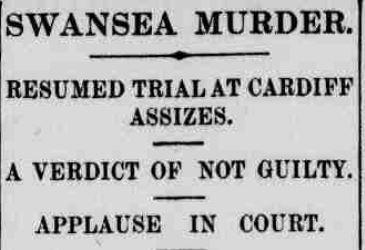
So Rhys returned home to a hero’s welcome in Brynhyfryd, to be carried shoulder high through the streets. I believe they do something similar if a local child passes GCSE Maths. But certainly, Rhys was ready to rebuild his life. His horse had died, his cart had rotted in the rain and he had lost weight in prison because he had had no butter. He was going to get a labouring job to begin with and earn some money so he could continue his old business. First though, he intended to go and rest for a week or so on a farm. It has always been good to have a plan.
His defence counsel said they had lots of information that could lead to a conviction, if funds were forthcoming for detective work. The police had tried to make the evidence fit a pre-conceived verdict. All they had to do, said the defence team, was to look at the evidence again and they would be able to see where it led. The argument they presented was certainly compelling enough. The police had never been asking the right questions; had never been open-minded enough. They had decided that Rhys was the murderer and shaped their approach to fit their preferred outcome.
You see, this alternative version had emerged in court but it was not explored in the trial, where the duty of the defence was always to set Rhys free and to that ensure an innocent man escaped the gallows. This compelling story came from John Thomas, who lived close to the Hill family. Don’t worry, you haven’t missed anything. This is the first time you have heard of him.
On the morning when Jesse disappeared in 1896, John Thomas had seen him in his cabbage garden with his brother James. They were talking loudly, quarrelling it seemed. At one point, Jesse was pushed back against the wall of a shed. Other members of the Hill family –James, Thomas and William and his wife, had been there, as well as a man called Nancarrow, who had been cutting cabbages that morning with a butcher’s knife. John Thomas had later seen three men run across the field from the shed and disappear into William’s house. He had told the police about this, though they didn’t seem too interested. And he was sure he had heard the brothers talking to a man called Maxworthy, who they seemed to be hiring to do something for them.
Remember, you are most likely to be murdered by someone who knows you.
But sadly the police were neither so well informed nor so open-minded. The hand that held the hammer, the hand that held the knife? Neither was the hand of Rhys Davies. And the murder remains unsolved still..
In July 1899, David Jones submitted a claim to the Watch Committee, which managed policing in the town, for compensation for loss of business as a consequence of being the chief witness in the case. His claim was dismissed.
Rhys Davies died of pneumonia in Treherbert in April 1907. He never spoke about his trial to anyone.
This is the first time I have published this story – it has not previously appeared anywhere in any of my books
I have now received new stock of my book Swansea Murders. The book contains 25 crimes which were committed between 1770 and 1946.
You can go straight to the How to Buy Page by using the menu or by clicking here.
.
My latest book is Grave Tales From Wales, which examines the stories beneath thirty Welsh graves. If you would like to find out more, then find the book in the menu or click on this link
If you want an example of what the book is about, then click on the link below and listen to me narrating the section about the Robber’s Grave in Montgomery, Powys
Very intetesting, especially as my daughter lives in Manselton.
Enjoyed reading this as i was brought up around brynhyfryd/landore area, my great grandparents lived at 66 penfilia rd, I also live on penfilia rd,I am sooo looking forward to receiving ‘Swansea murderers’